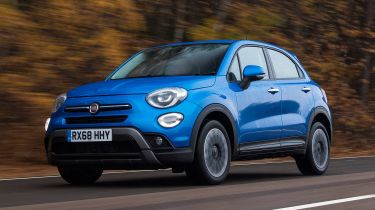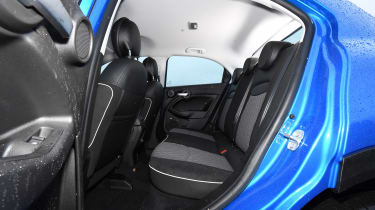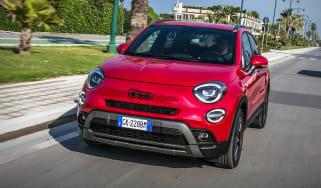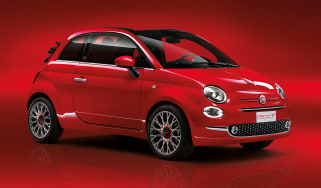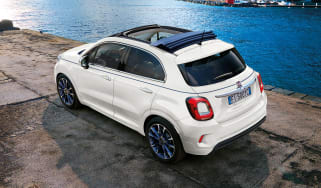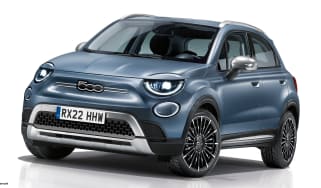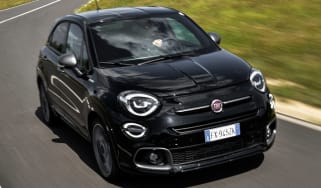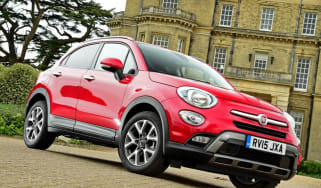Fiat 500X (2015 to 2024) review
The Fiat 500X gets the retro looks of the 500 city car and grafts them on to a small crossover body

The Fiat 500X is one of the more style-focused offerings in the small SUV/crossover class. It does a good job of extending the iconic design cues of the 500 city car into this segment. Not everyone will fall for the cutesy looks, but those who do will find it a practical lifestyle accessory – even if Fiat no longer offers the more rugged 4x4 version.
With a chassis shared with the Jeep Renegade, the 500X’s dynamics and handling on the road are surprisingly sharp, while the latest petrol engines boost efficiency and performance. We’d go so far as to say the high-speed refinement is exemplary for a car in this class, making it a perfect small family car for the fashion-conscious buyer.
With so many crossovers for sale in the UK, the Fiat 500X needs something special to help it stand out. And as its name suggests, that something is a retro look inspired by the evergreen Fiat 500 city car. But while the looks are similar, the 500X is a lot bigger, and it would suit somebody who likes the look of the 500, but needs a bit of added practicality.
Under the skin, the Fiat 500X shares running gear with the Jeep Renegade, while other rivals that offer similar space and upmarket appeal include the Mazda CX-3, MINI Countryman and Audi Q2. These cars are slightly larger than other rivals, such as the Peugeot 2008 and SEAT Arona.
Used - available now

2021 Vauxhall
Grandland X
22,876 milesManualPetrol1.2L
Cash £11,478
2021 Kia
Ceed Sportswagon
28,054 milesManualPetrol1.5L
Cash £14,749
2022 Mazda
CX-30
26,383 milesAutomaticPetrol2.0L
Cash £16,963
2026 BMW
i4
18,231 milesAutomaticElectric
Cash £28,300A comprehensive range update in 2018 saw Fiat drop the 500X diesels completely. There's no 4x4 version any more due to low sales, either, so all cars are front-wheel drive. The trim line-up now consists of Urban, Lounge, City Cross, Cross Plus and Sport.
As you might expect, there are subtle differences in the way Urban and Cross models look, with the latter getting chunkier bumpers, roof rails and extra body cladding to emphasise its faux-off-road appeal. The Urban models start at around £19,000, with the Lounge an extra £1,200. The flagship Sport model tops out at just over £25,000.
Petrol engines are fitted across the board, and the line-up features Fiat's new FireFly powerplants. In 2019, Fiat dropped the old 1.6 eTorq motor, and while that's no hardship in itself, it does mean the 500X's basic list price has risen by around £1,000.
Anyway, we'd always recommended skipping that most basic version, as the newer 1.0 and 1.3 turbocharged FireFly engines are more powerful yet also more efficient. The 1.0 is a three-cylinder turbo with 118bhp and a six-speed manual gearbox, while the 1.3 is a 148bhp four-cylinder with a six-speed DCT auto.
All trim levels can be specified with either engine, with the exception of the entry-level Urban, which is only available with the 1.0-litre unit. The 1.3 represents a price premium of around £2,500 over the 1.0-litre.
Engines, performance and drive
The huge variation in the way the 500X used to drive has gone with the trimming of engine and gearbox options.
Gone is the 1.6-litre non-turbo petrol, as well as both the 1.3 & 2.0-litre diesels. The nine-speed auto box and any 4WD option have been removed, too. All cars are now powered by peppy turbo petrol engines.
The lower weight in the nose boosts the 500X's handling, and the Fiat feels agile for a high-riding crossover. On the right road, the handling is surprisingly sharp and there’s loads of grip, even if four-wheel drive is no longer offered. On the motorway the cabin is whisper quiet, too, making the car well suited to long trips.
We have concerns about the ride on bigger wheels, though, and if you go for a model fitted with 18- or 19-inch alloy wheels, you may well notice the car fidget and shake more over poor surfaces.
Engines
There are two petrol engines in the 500X line-up. The old 1.6 E-TorQ 110 was ditched in 2019, but that's no hardship as it felt strained and wasn't all that economical. It offered a fairly weedy 109bhp and was good for 0-62mph in 11.5 seconds, with a maximum speed of 112mph.
The new entry-level motor is the 1.0-litre turbocharged FireFly, which is available in all model grades. It makes 118bhp with 190Nm of torque, and gives the 500X a 0-62mph time of 10.9 seconds and a 117mph top speed. It's much peppier and punchier than the old E-TorQ unit, and suits the car down to a tee.
The four-cylinder 1.3 FireFly engine has 148bhp and comes with a twin-clutch DCT semi automatic gearbox as standard. It still drives the front wheels, and has a 0-62mph time of 9.1 seconds – while top speed is 124mph. The six-speed DCT gearbox is a lot better than the old nine-speed transmission.
MPG, CO2 and running costs
The 2018 update saw prices rise for the 500X, and they jumped again the following year when Fiat dropped the basic 1.6-litre E-TorQ petrol engine. But, the pricier FireFly-powered versions may be more expensive, but they're vastly superior when it comes to on-road driving dynamics.
The range kicks off at around £19,000 for a 500X Urban with the 1.0-litre turbo petrol engine. Opting for the more rugged City Cross will cost roughly £1,200 more, while speccing the faster 1.3 auto is another £2,500-ish. There's also the Cross Plus, which adds more kit for around £1,800 extra.
With the removal of the diesels, the most efficient engine in the 500X is the 1.0 FireFly three-cylinder turbo petrol. It comes with a six-speed manual gearbox, and claimed economy of 43.5mpg. CO2 emissions start from 147g/km, but will increase depending on which trim level you opt for.
Go for the 1.3 FireFly with the standard DCT auto gearbox, and there's a claimed economy of 42.2mpg and emissions from 152g/km.
Range-topping Sport models offer a range of cosmetic tweaks and a few more substantial changes under the skin. Prices start from just over £23,000, but performance and economy isn't affected.
Insurance groups
Insurance groups range from group 10 for the entry-model Urban to group 16 for cars powered by the 1.3 petrol. Although performance from the Fiat isn’t electrifying, these are still competitive rates.
By way of comparison, the Nissan Juke starts at Group 11 and goes up to group 20, but there’s nothing in the 500X range to compare with the Juke 1.6 Tekna’s 134mph top speed and 0-62mph time of 7.8 seconds.
Depreciation
The Fiat 500 city car is a decent performer at resale time, but the 500X could do better. You're looking at average residuals of 36% after 3 years/36,000 miles, which isn't a brilliant return when you consider some small SUVs can achieve figures around 10% higher.
To get an accurate valuation on a specific model check out our free car valuation tool...
Interior, design and technology
The 500 isn’t the best car in its class in any one department, yet it’s sold almost 1.5 million units worldwide since its launch. Why? Because it looks cool.
Fiat claims that for 60% of buyers in the compact crossover class, styling is their primary motivation, and in that respect the 500X is a clever piece of design. The 500’s retro cues, such as the double circular headlights, ‘moustache’ grille and curved panels have been up-scaled into something altogether more macho.
Urban versions get smoother, sportier-looking front and rear bumpers, while upgrading to Lounge-spec offers bigger 17-inch alloy wheels and body-coloured mirrors. Cross models have a more rugged appearance thanks to chunkier bumpers, visible underbody protection and roof rails. Finally, the newer Sport trim offers some racier touches and red detailing to emphasise the sporty looks, even if performance is no different from the rest of the range.
The 500X is a much bigger car, don’t forget – longer, wider and taller - than many small crossover rivals including the MINI Countryman, Renault Captur and Nissan Juke, which gives it a certain amount of extra presence on the road.
On the inside, the 500-inspired retro theme continues with colourful body-coloured plastic inserts stretching right across the dash, and splashes of chrome on the door handles and vent surrounds. There’s a more three-dimensional feel, though, with the protruding instrument binnacle and the infotainment screen rising out of the dash.
While the Urban cars get shiny body-colour inserts on the fascia, giving the cabin a more premium feel, if you go for the Sport trim you get more utilitarian grey inserts which don’t do as much for the interior ambience.
Sat-nav, stereo and infotainment
Depending on spec, you can have steering wheel controls, Bluetooth hands-free and music streaming, plus Fiat’s Uconnect system as part of the infotainment package.
A seven-inch touchscreen is standard, while DAB radio, plus Apple CarPlay and Android Auto are included across the range. The Cross Plus and Sport models include sat-nav and extra USB ports in the front and rear of the cabin.
Practicality, comfort and boot space
The 500X is only available in a single body type, and it’s essentially a five-door hatchback in the pumped-up crossover style. It sits between the 500 and the 500L in terms of interior space, and should be big enough for most young families.
The driving position is higher overall than the 500, but you sit in a lower, sportier position within the car. Up front there are two glove boxes, large door pockets and a deep storage bin underneath the armrest.
There have been compromises to practicality in the pursuit of style though – the rear window is tiny, which makes visibility a pain, and the seats are not the most supportive.
Dimensions and size
The 500X is vast compared to the old Fiat 500s, and it’s even bigger than the van-like 500L - at 4,248mm nose-to-tail it will take up 10cms more of your drive. The 500X is a little lower (1,600mm vs 1,665mm) and a few cms wider (1,796mm vs 1,784mm).
The 500X is also noticeably bigger than the 4,135mm Nissan Juke, the 4,122mm Renault Captur and the 4,222mm Skoda Yeti, but a few mms shorter than the 4,255mm Jeep Renegade, with which it shares a platform.
Leg room, head room & passenger space
Rear passengers who are shorter than six-foot will have enough headroom and legroom, but if you're any taller it starts to become a squeeze. There are ISOFIX points for child seats in the rear bench as standard.
Boot space
At 350 litres, expanding to 1,000 litres with the 60/40 split rear seats folded down, the boot is actually smaller than the Countryman, Juke and Captur, but considering 60% of buyers in this class name styling as their number one motivation, Fiat won’t be too worried about that.
The boot space itself has a useful wide opening, while a moveable boot floor can be set at two levels - one level with the boot lip for easy loading and a flat boot floor with the rear seats folded down, and the other lower down to maximise space.
Reliability and safety
Reliability and build quality have traditionally been a sticking point for Italian cars, and customer feedback suggests Fiat still has a way to go when it comes to quality and service. The manufacturer finished in 23rd place out of 30 manufacturers in our latest Driver Power customer satisfaction survey.
The regular Fiat 500 achieved 45th position out of the top 75 cars when it came to reliability. Although, you can’t read too much into this because the 500X uses an entirely different platform (it's based on the Jeep Renegade, which didn't feature in our survey) to the 500, and feels better built than you might expect.
In terms of cutting-edge safety equipment, the 500X breaks new ground for Fiat. Buyers can choose from different option packs (which save them up to 30% compared to buying the options separately), one of which, called the City & Safety Plus Pack, includes high-end tech including adaptive cruise control, city brake control, blind spot assist and a rear parking camera for squeezing into and out of tight spots.
Sadly, that wasn’t enough to convince the Euro NCAP crash testers, who only awarded the 500X four out of five stars in 2015. Adult occupant protection was rated at 86% and child protection at 85%.
Warranty
It has a three-year warranty, but the 500X does get the benefit of unlimited mileage. Many three-year packages from other manufacturers include a 60,000 mile limit – although you can’t ignore the fact that Hyundai and Kia offer five- and seven-year deals. The Jeep Renegade, which shares many parts with the 500X, gets a five-year warranty.
Servicing
Annual interim service intervals for the 500X are recommended, while the petrol models have a major service at two years or 30,000 miles.
